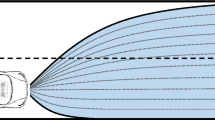Abstract
This study aims to develop car following models which simulate various adaptive cruise control (ACC) behaviors for a microscopic traffic simulator. There is a need for a microscopic traffic simulator to evaluate the impact of ACC penetration on highway traffic conditions. If the method of modeling of the simulator follows ACC technology as it is in the real world, the update frequency will be in millisecond order. This may result in an unexpected increase in the calculation time and often spoil the practical use of the simulator. To avoid this situation, it is necessary to develop a car following model which can simulate ACC with sufficient accuracy for impact assessment and which works in sub-second frequency, which is common for many microscopic traffic simulators. This paper outlines the Intelligent Driver Model and its derivations, which have many preferable features. Those model equations are modified to simulate three types of ACC behaviors which retain distance gap, time gap and time headway, and we verified their behaviors through computational platoon experiments with four cars.























Similar content being viewed by others
References
Marsden, G., McDonald, M., Brackstone, M.: Towards an understanding of adaptive cruise control. Transp. Res. C 9, 33–51 (2001)
Tsugawa, S., Kato, S., Aoki, K.: “An automated truck platoon for energy saving”, Proceedings of Intelligent Robots and Systems (IROS), CD-ROM (2011)
Kesting, A., Treiber, M., Schönhof, M., Helbing, D.: Adaptive cruise control design for active congestion avoidance. Transp. Res. C 16, 668–683 (2008)
Treiber, M., Hennecke, A., Helbing, D.: Congested traffic states in empirical observations and microscopic simulations. Phys. Rev. E. 62(2), 1805–1824 (2000)
Schakel, W., Arem, B., Bart, N.: “Effects of cooperative adaptive cruise control on traffic flow stability”, Proceedings of 13th International IEEE Annual Conference on Intelligent Transportation Systems, Madeira Island, September 19–22, CD-ROM (2010)
Brackstone, M., McDonald, M.: Car-following: a historical review. Transp. Res. F 2, 181–196 (1999)
Newell, G.F.: A simplified car-following theory: a lower order model. Transp. Res. B 36, 195–205 (2002)
Acknowledgments
The authors would like to thank the Ministry of Economy, Trade and Industry (METI) in Japan and the New Energy and Industrial Technology Development Organization (NEDO) in Japan for their support for the study, and also appreciate the great efforts of the member of the ‘Energy ITS’ project.
Author information
Authors and Affiliations
Corresponding author
Rights and permissions
About this article
Cite this article
Horiguchi, R., Oguchi, T. A Study on Car Following Models Simulating Various Adaptive Cruise Control Behaviors. Int. J. ITS Res. 12, 127–134 (2014). https://doi.org/10.1007/s13177-013-0077-5
Received:
Revised:
Accepted:
Published:
Issue Date:
DOI: https://doi.org/10.1007/s13177-013-0077-5




